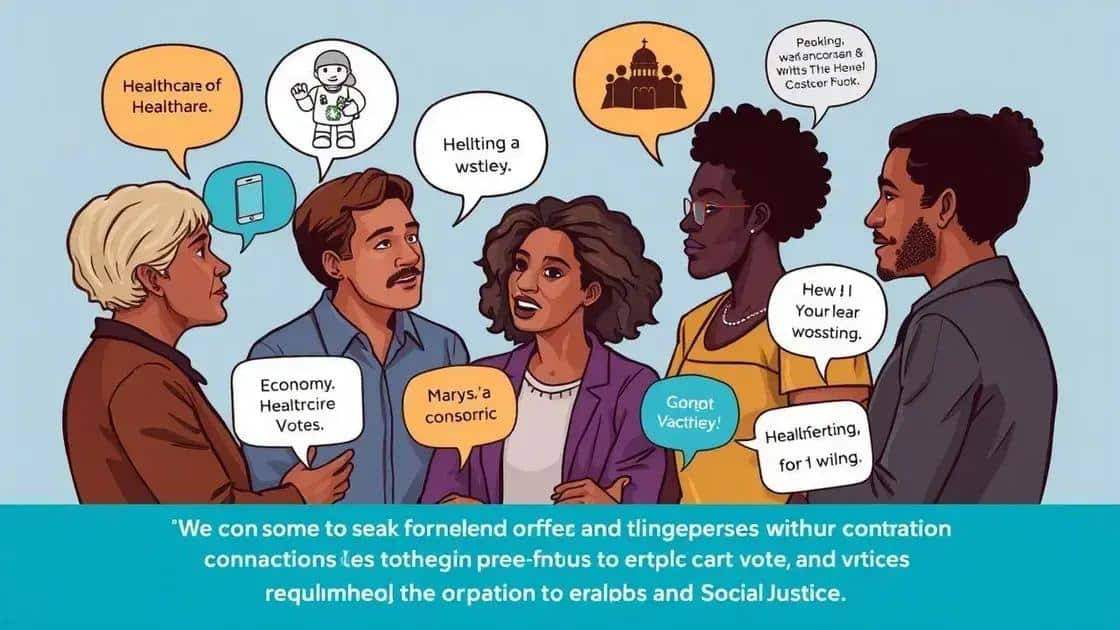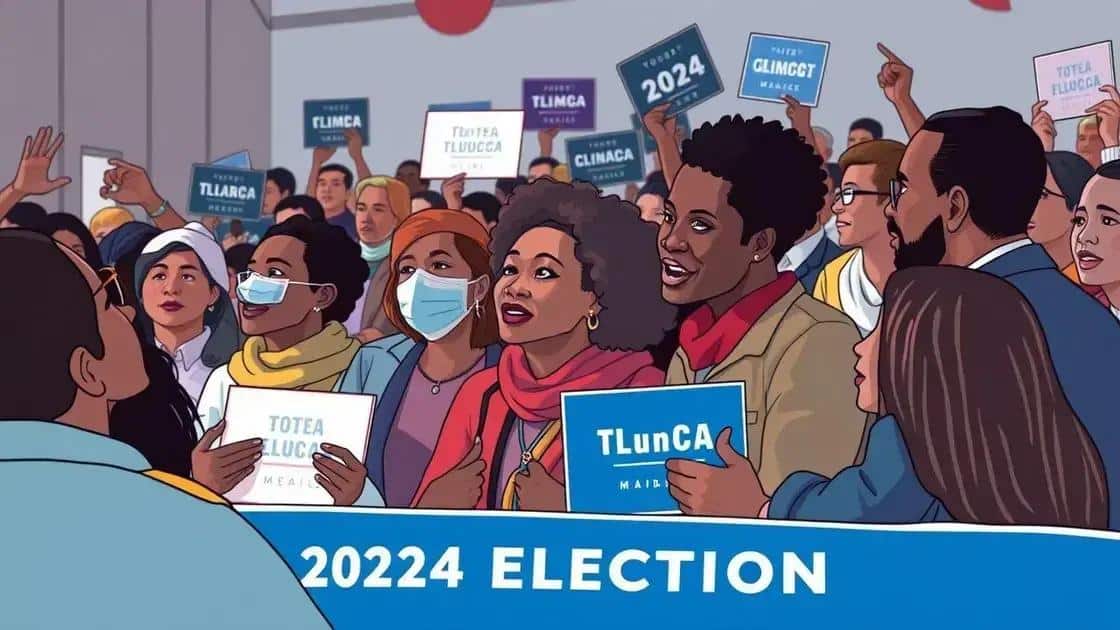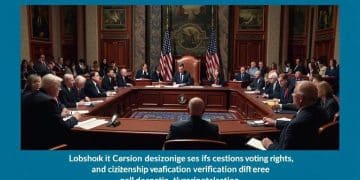Polls reveal shifting public opinion against Trump’s policy proposals

Anúncios
Polls reveal shifting public opinion against Trump’s policy proposals, highlighting key voter concerns regarding healthcare, climate change, and economic stability as critical factors influencing the upcoming 2024 election.
Polls reveal shifting public opinion against Trump’s policy proposals. This change could have far-reaching implications, and it’s worth understanding what’s driving these sentiments. Are people’s concerns valid, or do they stem from broader political trends? Let’s dive in.
Recent polling data on Trump’s policies
Recent polling data on Trump’s policies sheds light on how the American public views various proposals. Understanding these trends can help us see shifts in political sentiment and priorities. Polls show that opinion isn’t static; it’s influenced by numerous factors.
One interesting aspect comes from examining the demographics involved. Different age groups and backgrounds respond uniquely to each policy. For example, younger voters often express a desire for more progressive policies, while older generations may lean towards traditional viewpoints. This variety in responses makes the polling data rich for analysis.
Key Issues Influencing Public Opinion
A few issues stand out when we analyze the current polling landscape:
- Healthcare: Voters’ concerns about access to affordable healthcare options significantly affect their opinions on various policies.
- Economy: Issues such as job creation and economic stability often dominate discussions during polling periods.
- Immigration: Opinions on immigration policies remain a hot topic, where many feel strongly on either side.
As we dive deeper into the numbers, we find that the political climate can propel certain topics to the forefront, swaying public opinion. News cycles also contribute heavily to shaping viewpoints, as recent events can alter perceptions rapidly. Additionally, social media plays a significant role in spreading information and influencing opinions.
Polling does not just reflect current sentiments; it also predicts future trends. When voters express dissatisfaction with certain policies, it’s a clear signal to the political landscape. This feedback loop is essential for understanding which proposals may need reevaluation or modification.
Overall, keeping an eye on the shifting data can provide insights into the direction American voters may be leaning as they navigate an ever-changing political environment.
Key issues influencing public opinion

Key issues influencing public opinion can vary widely, especially within the context of political landscapes. Understanding these issues helps us grasp why voters feel a certain way about specific policies. Some of the most pressing concerns often revolve around aspects like healthcare, economy, and social justice.
These topics are frequently mentioned in polling data, indicating which areas resonate most with voters. For example, when it comes to political candidates, healthcare remains a top priority. Many people are worried about rising costs and the accessibility of services. This concern shapes their views on policies proposed by leaders.
Impact of Economic Factors
Another issue that heavily influences opinion is the state of the economy. Voters tend to support candidates who outline clear plans for job creation and economic growth. Economic stability can sway opinions rapidly.
- Unemployment rates: Higher unemployment can lead to a decline in support for current policies.
- Inflation: Rising prices can affect how people feel about their economic conditions.
- Tax policies: Discussions on taxes often generate strong reactions from the public.
Moving beyond economics, social issues also play a key role in shaping public sentiment. Issues like racial inequality and climate change are resonating strongly with many voting groups today. For instance, younger voters are particularly passionate about environmental policies. Their views can significantly impact polling outcomes, as they demand action on these critical topics.
Furthermore, the role of media coverage cannot be overlooked. News outlets and social media platforms frequently bring attention to specific issues, which can lead to shifts in public opinion almost overnight. As perceived problems evolve, so too does public response. This dynamic landscape highlights the importance of monitoring these key issues continually.
Comparative analysis with past administrations
When looking at a comparative analysis with past administrations, several key differences and similarities emerge. Understanding how previous leaders approached various policies helps to frame current shifts in public opinion.
For example, looking at economic policies, past presidents often faced similar challenges. They had to navigate issues like unemployment and inflation. Where modern leaders might emphasize digital innovation and technology growth, earlier administrations focused strongly on industrial growth and job creation in manufacturing.
Healthcare Initiatives Over Time
Examining healthcare policies reveals a shifting landscape. Many presidents have made significant changes to healthcare.
- Clinton Era: The focus was on comprehensive reform proposals that ultimately did not pass.
- Obama Administration: The Affordable Care Act expanded healthcare access for millions and shaped public expectations.
- Trump Era: Emphasized dismantling the ACA, leading to significant shifts in public sentiment regarding healthcare access.
Each administration’s approach has influenced how the public perceives their policies today. The idea of healthcare as a right versus a privilege remains a dynamic topic, deeply rooted in previous actions.
Another area of comparison is environmental policy. Earlier administrations often prioritized economic growth over environmental concerns, while more recent ones view sustainability as essential. President Obama’s signing of the Paris Agreement marked a significant shift toward global cooperation on climate action.
In contrast, the current administration has faced backlash for some environmental decisions, showing how public opinion can quickly sway based on policies implemented. Analyzing historical trends provides insight into how today’s leaders can learn from past successes and failures. This knowledge is crucial for shaping effective and resonant policies moving forward.
Implications for the 2024 election

The implications for the 2024 election are significant as public opinion shifts regarding policy proposals. As polls gather data on what people think about current leadership, it becomes clear that voter priorities are changing.
Today’s electorate is more aware of pressing issues, such as healthcare access, climate change, and economic stability. This growing awareness can shape party platforms as candidates prepare for the upcoming election.
Shifting Voter Demographics
One major implication is the changing demographics of voters. Younger voters are increasingly becoming a powerful force at the polls. They tend to prioritize progressive policies, and their turnout can decide Election Day outcomes.
- Increased Engagement: Young people are more engaged with social issues. Their opinions can sway those of their peers.
- Diversity in Age: Candidates need to address the needs of various age groups to gain widespread support.
- Focus on Digital Media: Campaign strategies now heavily rely on social media to reach younger audiences effectively.
As important issues like the economy and healthcare take center stage, candidates who align their policies with public opinion could have a distinct advantage. Voters are looking for authenticity and solutions tailored to today’s problems, rather than traditional political rhetoric.
Another implication is the response of incumbent leaders. They may need to reevaluate their current policies to align with the sentiments expressed in polling data. Failure to adapt can lead to voter apathy or, worse, a shift toward opposition candidates who resonate more with the electorate’s concerns.
Ultimately, understanding the evolving landscape of public opinion is crucial for all parties involved. Precise measurements of voter sentiment will play a vital role in shaping campaign strategies, policy proposals, and voter outreach programs in the lead-up to the 2024 election.
FAQ – Frequently Asked Questions about Public Opinion and the 2024 Election
How are public opinions influencing the 2024 election?
Public opinions are shaping candidate platforms and strategies as they shift toward key issues like healthcare and climate change.
What role do younger voters play in the upcoming election?
Younger voters are becoming increasingly influential, prioritizing progressive policies and actively engaging in the electoral process.
Why is adaptability important for political leaders this election cycle?
Political leaders need to adapt their policies to align with evolving public sentiments to maintain voter support and relevance.
How can voters stay informed about the issues at stake?
Voters can stay informed by following reliable news sources, engaging in discussions, and participating in community forums to understand the key issues better.






